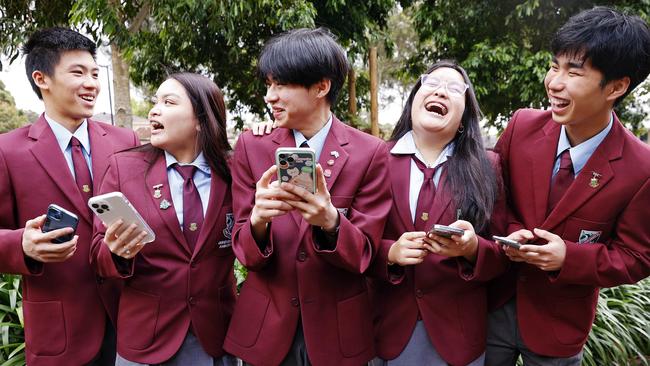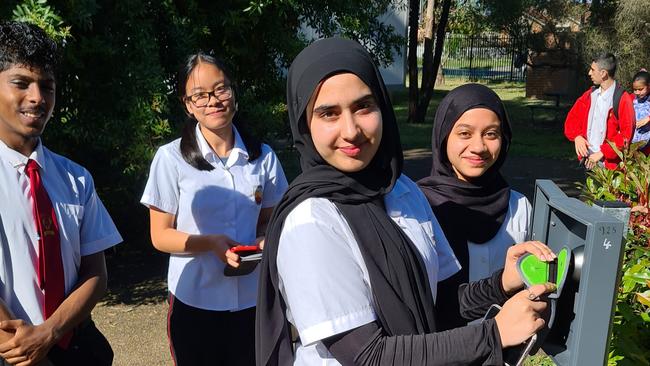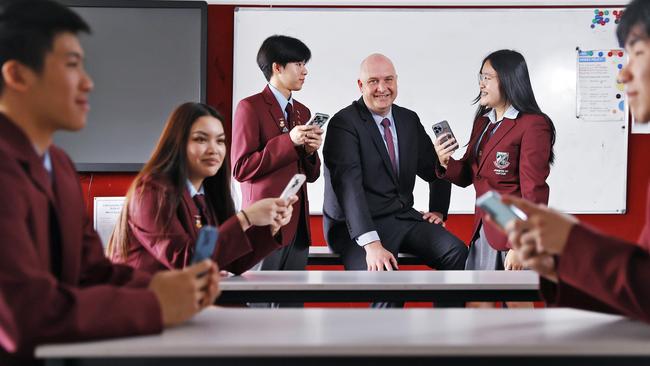Take them or trust them? Mobile phones in schools set to become an election battleground
The call to ban mobile phones in schools could become a battleground in the upcoming state election – but teens at the heart of the debate want to be heard | VOTE in our poll

NSW
Don't miss out on the headlines from NSW. Followed categories will be added to My News.
At the start of the school day, Plumpton High students lock their mobile phones in individual pouches, where they’ll remain until the bell rings at 3pm.
Over at Cabramatta High, there’s a different approach, with students allowed — nay, encouraged — to use their phones throughout the school day to aid their learning.
For both schools, the systems are working.
Trusting high school principals to implement their own mobile phone policy based on what works best for their communities is the approach being taken by the NSW government.
But it’s one that has drawn both praise and criticism and with NSW among just a few jurisdictions in the country yet to ban mobile phones at high school, the push to do so is gaining momentum.
This month the Northern Territory announced a blanket ban on phones in all public schools from 2023, joining similar policies in Victoria, Tasmania and Western Australia.
NSW Labor has promised to ban phones in schools should it win the state election in March, but NSW Education Minister Sarah Mitchell maintained that a “one-size-fits-all approach” was not always practical.
The NSW Department of Education surveyed high schools prior to the policy implementation in 2020 and found 70 per cent had implemented a ban, with 30 per cent imposing partial or no restrictions.
“As the COVID-19 pandemic highlighted, digital devices when used appropriately have an important role to play in keeping students connected and can support learning and engagement,” Ms Mitchell said.

“We cannot ignore the role technology plays in our lives, and it is important that high school students learn how to use devices responsibly.
“In our primary schools, mobile phones are banned. In high schools we trust our principals, who know their school communities, to make decisions on how they manage digital devices in consultation with their families, students and staff.”
But Ms Mitchell’s approach was a “failure of leadership” said child and adolescent psychologist Dr Michael Carr-Gregg.
“Generally the lived experience of schools who have put bans in place is that there’s been less distraction in classrooms, better grades for students, less cyberbullying, less staging of fights in the playground and greater levels of socialisation,” he said.
IMPULSE CONTROL
“I think it’s naive to say students should be allowed to learn to self regulate their mobile phone use, when they’re at an age where the parts of their brain for impulse control are not fully developed.”
Not all experts agree. Dr Joanne Orlando, a digital expert at Western Sydney University, said while a ban on phones in schools was a “popular political move”, there was little evidence of long-term benefits.
“In lockdown, children did us really proud — they did their schoolwork virtually and displayed great tech skills and ability to control themselves,” she said.
“Now to backflip and say ‘we don’t trust you to learn with the technology at your fingertips’ is sending mixed messages.”
PARENTS BACK BAN
Most parents, though, are in favour of a ban. Many have written to Ms Mitchell with their concerns, while an online petition to ban phones at recess and lunch started by the North Shore Mums online group has garnered 25,000 signatures.
Group founder Rachel Chappell said phones should be banned at breaks to enable kids to socialise, play and be active.
“One of the members of our Facebook group told us her son in Year 7 was struggling to make friends, as all the other kids were on their phone at lunch times and recess,” she said.
“We believe that kids spend so much time on screens in class that during the breaks they need to have a break from their screen and interact in the real world.”
A small group of southern Sydney parents have gone further, starting a movement called the Heads Up Alliance which encourages parents to delay getting smartphones for their kids, at least until year nine.
Labor’s education spokeswoman Prue Car said a Labor government would ban phones in high schools to help kids learn and stay safe.
“There has been a lot of parent groups as well as teachers advocating to have some sort of systemwide approach,” she said.
“We want to conduct a review of what’s working where, with the aim of working towards a ban on phones from Year 7 to 12.
“We want to be looking to create schools that are as safe as possible. Where high school students are not distracted by technology, where they have every opportunity to get the best outcomes.”

Back at Plumpton High, they tried to ban phones just at breaks but it didn’t work, so a few weeks ago it became the latest school to use the Yondr pouches to create a phone-free space.
The system cost around $14,000 to set up for the first year, and it’ll cost $9500 in subsequent years, but they’re already reaping the rewards said principal Tim Lloyd.
He estimated students, and teachers, had gained at least 10 minutes of learning time back each lesson without the distraction of phones.
“It’s been fantastic, students are engaged more in learning and there’s been a significant increase in student interaction at breaks as well as more physical activity,” he said.
“Teacher can unlock phones if students need to use them in class. But we want to train them that while this type of technology has fantastic applications, it’s about using them when it’s appropriate.”
Yet at Cabramatta High, teaching students to be responsible “digital citizens” has worked said principal Lachlan Erskine.
“Our approach is one of digital citizenship and self responsibility,” he said.
“We recognise mobile phones are part of life for not just teens but adults as well, so we want students to learn to use them responsibly.”
Cabramatta teachers used mobile and other devices in the classroom to complement and enhance learning, he said. In the school’s intensive English centre for example, students used them as a translation tool.
“Each school context and community is different so the approach can be different,” Mr Erskine said.
Students said they were comfortable with the policy.
“Compared to other schools our school is very relaxed, but it works. We know the boundaries — when it’s time to use them, and time to put them away,” Year 11 student Jennifer Ho said.





